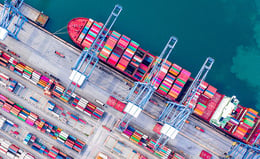5 Steps for Creating a More Sustainable Supply Chain
Nick Ostdick - March 24, 2016

Several of our more recent articles have examined the newest trends innovating today’s global supply chain industry. From the Internet of Things to Industry 4.0, much of the latest thinking about supply chain efficiency and visibility has involved a significant scale up in terms of the technology supply chain planners and managers use on a daily basis. Yet one of the most forward-thinking trends finding traction in the supply landscape actually involves something of a scale down in terms of the supply chain’s environmental impact.
 The idea of sustainability – a holistic view of supply logistics and technology that focusses on environmentally and socially responsible practices beyond accuracy of inventory, delivery, and data reporting and analysis – has in recent years become more crucial to end-to-end supply stream visibility, transparency, and agility.
The idea of sustainability – a holistic view of supply logistics and technology that focusses on environmentally and socially responsible practices beyond accuracy of inventory, delivery, and data reporting and analysis – has in recent years become more crucial to end-to-end supply stream visibility, transparency, and agility.
As manufacturers, suppliers, distributors, and transportation outfits expand to new and emerging markets across the globe, the competition for resources has increased exponentially and forced supply planners and managers to take a good hard look at their supply practices in order to conserve resources, reduce costs, and increase productivity.
In short, operating a leaner, more sustainable supply chain in the 21st Century not only benefits the environment, but can also be a boon to companies as they look to leverage new technologies and strategies to streamline existing supply practices.
Challenges in Adopting Sustainable Practices
As with any new innovation or trend, challenges abound when thinking how to develop and execute a more sustainable supply pipeline. Whereas the implementation of intelligent planning and reporting systems may be more mechanical or technical in nature. Adopting sustainability practices into a supply stream may require planners and managers to rethink how they conceive their supply chain at-large – in a sense, the challenge of supply chain sustainability is adopting a new cognitive process about the use of resources at all points in the supply stream.
The hurdles supply chain planners and managers should understand when evaluating how best to incorporate sustainable practices into their supply stream include:
- Understanding and analyzing how your current supply chain functions. The ability to prioritize the needs and requirements of your current supply stream is essential in fostering cost-effective and sensible sustainability decisions. Sustainability initiatives are not a one-size-fits-all solution.
- Learning to collaborate with new and expected partners or vendors. Implementing sustainable supply chain practices means reevaluating a planner’s “business as usual” mentality, and this reevaluation often means creating customer and/or vendor relationships with organizations once thought to be outside the supply steam universe. Supply planners and managers need to embrace these new collaborations and view them as a crucial part of the greater supply pipeline.
- Reexamining how you conceive sustainability. Part of embracing sustainable supply chain practices requires planners and managers to reexamine how they define sustainability. Sustainable practices need to be conceived as an opportunity rather than an inconvenience – a chance to invigorate and innovate your supply stream strategies as opposed to handcuffing them. It’s also important to consider sustainability at all points in the supply stream rather than just at the manufacturing or transportation levels.
 Benefits
Benefits
Once a manufacturer, supplier, or distributor accepts and overcomes the initial hurdles in adopting sustainable supply chain practices, the benefits to a company’s supply stream become immediately clear. While it may take some time for a company to see actionable data or reporting as an indicator of these benefits, value-added propositions for sustainable practices will without doubt pay dividends as the supply chain industry continues to globalize.
Some of these benefits include:
- Reduced overall costs across all points of the supply stream – administrative, operational, freight, and data gathering and management.
- Conversation of resources – both material resources relative to manufacturing and freight, but also in terms of manpower.
- New products and process innovations – looking at a supply chain through the prism of suitability can lead to opportunities for new products, processes, and business strategies.
- Increased productivity – the very nature of sustainable supply chain practices leads to a reduction of material and manpower waste, and fosters an increase in productivity and efficiency through lean, streamlined processes.
Steps for Sustainability
As discussed earlier, a sustainable supply chain and the strategies for achieving sustainability across all points of the supply stream is not a one-size-fits-all solution. Each company is different and as such each company needs to adopt the strategies that best align with their vision and outlook for the future. However, here are a few steps manufacturers, suppliers, distributors, and retailers can take to encourage more sustainable supply practices and foster creativity and collaboration in engineering a more efficient end-to-end supply stream.
1). Map Your Supply Chain: In order to identify areas most in need of sustainable supply practices, suppliers and managers must inventory all points of the supply pipeline to evaluate the operation in a holistic a manner. This includes evaluating vendors, third-party collaborations, and connections to other outside organizations to pinpoint points of waste and inefficiency. Identifying potential drags on a more sustainable model will help planners and managers devise strategies that best address a particular point in the pipeline.
2). Establish Realistic Expectations: It’s important to realize that sustainable practices and business goals or objectives are not necessarily competing propositions. Once a supply chain has been mapped and areas for improvement identified, planners and managers can then communicate expectations about sustainability benchmarks and progress-points to those inside the supply stream. Establishing these expectations also provides a roadmap for implementation that helps designate responsibility and accountability to right players inside the supply pipeline.
3). Create Baselines and Key Performance Indicators (KPI's): Simple questionnaires, surveys, data gathering, and other types of feedback and reporting are essential to monitoring the impact of sustainable supply logistics and making adjustments to existing practices to foster greater ROI (returns on investment). Creating, sharing, and understanding how these metrics or KPI's are to be applied will also engender an atmosphere of inclusivity throughout the supply stream.
4). Develop Training and Education Programs: Knowledge is power. It’s a cliché for a reason. Providing those within the supply chain literature, training, and education on the benefits and necessity of sustainable supply practices in today’s supply landscape will go a long way toward helping the major players reimagine how they operate and function in today’s global supply market. Several consulting organizations offer sustainability training and education programs, and companies should look at these programs as investments in their future.
5). Analyze the Results: Simply taking the steps to implement sustainable supply solutions is not enough – in fact, that’s just the beginning. Supply planner and managers need to remain vigilant as sustainable supply practices begin to take effect in order to enact any necessary course corrections and ensure the integrity and impact of sustainable initiatives. Maintaining a watchful eye on the established metrics and benchmarks for progress will help planners achieve end-to-end visibility and transparency.
 Sustainability for the Long Haul
Sustainability for the Long Haul
With so many advancements in intelligent supply solutions, technology, logistics, and strategy, it can sometimes be difficult to separate the trends and the fads from the initiatives with real staying power. But what distinguishes the idea of sustainable supply methods is the very fact that so many of the resources and materials necessary for supply chain operations are in finite supply. As the supply chain marketplace continues to diversify and expand into new and emerging markets, these limited resources will be under even more strain as more and more companies reach into a shrinking pot of materials and resources.
Companies that adopt sustainable supply practices will not only be contributing to a greater good for the industry at-large, but they’ll also be taking responsibility to ensure their survival long-term.
LATEST POSTS
- Understand Circular Economy in The Manufacturing Industry
- How Can Industry 4.0 IT Integration Be Achieved Smoothly?
- The Significance of Order Sequencing in Discrete Manufacturing
- How to improve your Supply Chain Management: The Power of Control Towers
- Optimizing Human Resource Scheduling in Manufacturing: A Technological Approach



